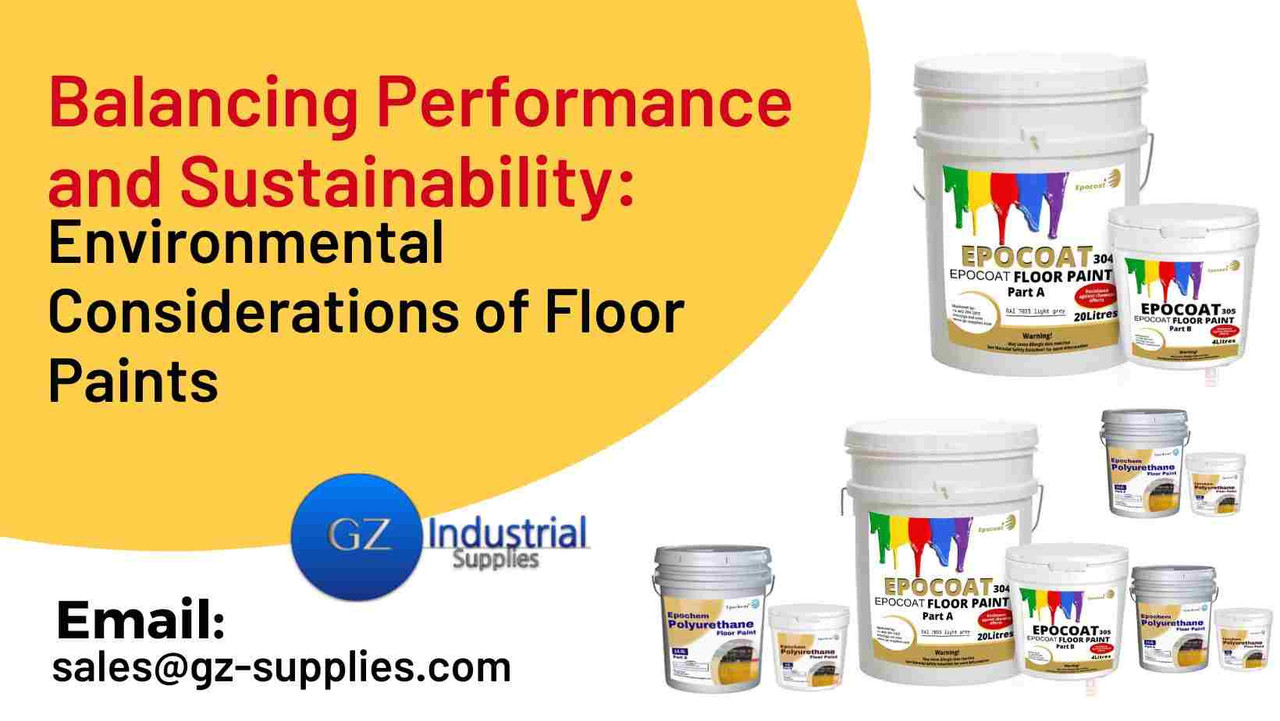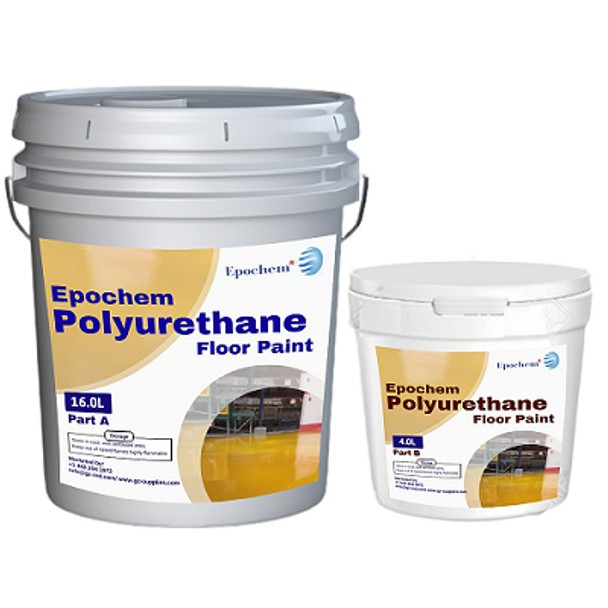Balancing Performance and Sustainability: Environmental Considerations of Floor Paints
When selecting floor paints for your facility, you face the challenge of balancing performance requirements with environmental considerations. As a facilities manager, you must weigh factors like durability, chemical resistance, and ease of maintenance against sustainability goals and regulatory compliance. This article will examine key environmental aspects of floor coatings, including VOC content, raw material sourcing, and end-of-life disposal. You will learn about innovative eco-friendly formulations that don't compromise on quality or longevity. By understanding these critical issues, you can make informed decisions to meet your operational needs while minimizing environmental impact and supporting your organization's sustainability initiatives.
 Epochem Polyurethane Floor Paint: Handles extreme temperatures – perfect for garages, warehouses, and more.
Epochem Polyurethane Floor Paint: Handles extreme temperatures – perfect for garages, warehouses, and more.
Factors to Consider When Choosing Floor Paint
When selecting floor paint for your project, several key factors must be taken into account to ensure optimal performance and environmental responsibility. Consider the following aspects to make an informed decision that balances durability, aesthetics, and sustainability.
Surface Compatibility
Before applying any paint, you must assess the compatibility with your floor's surface material. Different substrates, such as concrete, wood, or metal, require specific paint formulations to ensure proper adhesion and longevity. Consult with manufacturers or professionals to determine the most suitable paint type for your particular flooring.
Durability and Wear Resistance
The level of foot traffic and potential exposure to chemicals or heavy equipment will influence your choice of floor paint. High-traffic areas demand more robust, abrasion-resistant formulations to withstand constant use. Look for paints specifically designed for industrial or commercial applications if you anticipate heavy wear and tear.
Environmental Impact
As sustainability becomes increasingly important, consider the environmental footprint of your chosen floor paint. Opt for low-VOC (Volatile Organic Compound) or zero-VOC formulations to minimize harmful emissions and improve indoor air quality. Additionally, explore paints made from renewable resources or those that incorporate recycled materials to further reduce environmental impact.
Aesthetic Considerations
While performance is crucial, the visual appeal of your floor should not be overlooked. Consider the color, sheen, and finish options available to complement your space's overall design. Some paints offer decorative elements like flakes or metallic finishes, allowing you to achieve both functionality and style in your flooring solution.
 EPOCOAT 304/305 Floor Paint Creates a Slip-Resistant Surface. Perfect for industrial and home use.
EPOCOAT 304/305 Floor Paint Creates a Slip-Resistant Surface. Perfect for industrial and home use.
Comparing the Durability of Different Floor Paint Types
When selecting floor paint for your project, durability is a crucial factor to consider. Different types of floor paints offer varying levels of resistance to wear, chemicals, and environmental factors. Understanding these differences will help you choose the most suitable option for your specific needs.
Epoxy Floor Paints
Epoxy floor paints are renowned for their exceptional durability. These two-part coatings form a hard, chemical-resistant surface that can withstand heavy foot traffic, impact, and abrasion. You'll find that epoxy paints are particularly well-suited for industrial settings, garages, and high-traffic commercial areas. Their resistance to chemicals and solvents makes them ideal for environments exposed to harsh substances.
Polyurethane Floor Paints
If you're looking for a balance between durability and flexibility, polyurethane floor paints might be your best choice. These coatings offer excellent resistance to abrasion, chemicals, and UV rays. You'll appreciate their ability to maintain color and gloss over time, making them suitable for both indoor and outdoor applications. Polyurethane paints are often used in areas that require a combination of durability and aesthetic appeal.
Acrylic Floor Paints
For less demanding environments, acrylic floor paints provide a cost-effective solution with moderate durability. You'll find that these water-based paints are easy to apply and maintain, making them popular for residential use and light commercial applications. While not as resistant to heavy wear and chemicals as epoxy or polyurethane, acrylic paints offer good resistance to UV rays and are less likely to yellow over time.
When comparing these options, consider factors such as the expected foot traffic, potential exposure to chemicals, and the specific environmental conditions of your space. By carefully evaluating these aspects, you can select a floor paint that offers the right balance of durability and performance for your project.
 Airless Sprayer HVBAN EP310: Achieve flawless finishes faster with this professional-grade airless sprayer. Perfect for any painter.
Airless Sprayer HVBAN EP310: Achieve flawless finishes faster with this professional-grade airless sprayer. Perfect for any painter.
The Importance of Low-VOC Floor Paints
When considering floor paints for your space, it's crucial to understand the significance of low-VOC (Volatile Organic Compound) options. These environmentally friendly alternatives offer numerous benefits for both your health and the planet.
Understanding VOCs
Volatile Organic Compounds are chemicals that easily evaporate at room temperature, releasing harmful gases into the air. Traditional floor paints often contain high levels of VOCs, which can lead to poor indoor air quality and potential health risks. By choosing low-VOC floor paints, you're taking a proactive step towards creating a safer, more sustainable environment.
Health Benefits
Your health and well-being should be a top priority when selecting floor paints. Low-VOC options significantly reduce the emission of harmful chemicals, minimizing the risk of respiratory issues, headaches, and other health concerns associated with prolonged exposure to VOCs. This is particularly important in spaces with limited ventilation or where people spend extended periods.
Environmental Impact
By opting for low-VOC floor paints, you're not only protecting your immediate surroundings but also contributing to broader environmental conservation efforts. These paints produce fewer emissions during application and throughout their lifecycle, reducing your carbon footprint and helping to preserve air quality on a larger scale.
Performance and Durability
Contrary to common misconceptions, low-VOC floor paints don't compromise on quality or durability. Advancements in paint technology have resulted in formulations that offer excellent coverage, adhesion, and longevity while maintaining eco-friendly properties. You can achieve the desired aesthetic and protection for your floors without sacrificing environmental responsibility.
Regulatory Compliance
As environmental regulations become increasingly stringent, using low-VOC floor paints ensures that you're ahead of the curve in terms of compliance. Many regions have implemented strict guidelines on VOC content in paints, making low-VOC options not just a choice, but a necessity for future-proofing your projects.
Eco-Friendly Floor Paint Options
When considering environmentally responsible floor coatings, you have several eco-friendly options to choose from. These alternatives not only minimize your environmental impact but also provide durable and attractive finishes for your floors.
 International Paint Interbond 201 20L: Durable, low VOC coating that keeps your marine surfaces safe while protecting the environment.
International Paint Interbond 201 20L: Durable, low VOC coating that keeps your marine surfaces safe while protecting the environment.
Water-Based Paints
Water-based floor paints are an excellent choice for environmentally conscious consumers. These paints contain fewer volatile organic compounds (VOCs) than traditional solvent-based options, resulting in reduced emissions and improved indoor air quality. You'll find that water-based paints offer easy application, quick drying times, and simple clean-up with just soap and water.
Natural Oil-Based Paints
If you're looking for a more natural option, consider oil-based paints derived from plant sources. These paints often utilize linseed, soy, or other vegetable oils as their base. Natural oil-based paints provide a rich, durable finish while minimizing the use of petrochemicals. Keep in mind that these paints may have longer drying times compared to water-based alternatives.
Milk Paint
For a truly traditional and non-toxic option, milk paint is worth exploring. This centuries-old formula uses milk protein (casein) as a binder, combined with natural pigments for color. Milk paint is biodegradable, VOC-free, and safe for use in homes with children or pets. While it may require more frequent reapplication than modern synthetic paints, it offers a unique, matte finish that many find appealing.
Low-VOC and Zero-VOC Synthetic Paints
Advancements in paint technology have led to the development of low-VOC and zero-VOC synthetic floor paints. These options combine the durability and performance of traditional paints with significantly reduced environmental impact. When selecting these paints, be sure to check for third-party certifications, such as Green Seal or GREENGUARD, to ensure their eco-friendly claims are verified.
Frequently Asked Questions About Floor Paints
What are the main types of Floor Paint?
Floor paints typically come in two main categories: water-based and solvent-based. Water-based paints are generally more environmentally friendly, with lower volatile organic compound (VOC) emissions. Solvent-based paints, while often more durable, tend to have higher VOC content. Each type has its own advantages and drawbacks, depending on the specific application and environmental considerations.
How long does Floor Paint typically last?
The longevity of floor paint depends on several factors, including the quality of the paint, surface preparation, application technique, and level of foot traffic. In general, a well-applied floor paint can last anywhere from 2 to 5 years in high-traffic areas, and up to 10 years in low-traffic areas. However, environmentally friendly options may have slightly shorter lifespans, requiring more frequent reapplication.
Are there Eco-friendly Floor Paint options available?
Yes, there are increasingly eco-friendly floor paint options on the market. These include low-VOC and zero-VOC formulations, as well as paints made from renewable resources. Some manufacturers are also developing bio-based floor paints derived from plant materials. While these options may come at a higher initial cost, they often provide long-term benefits in terms of indoor air quality and reduced environmental impact.
How can I properly dispose of leftover Floor Paint?
Proper disposal of floor paint is crucial for minimizing environmental harm. Never pour paint down drains or into the ground. Instead, check with your local waste management facility for guidance on disposal methods. Many areas have special collection days for household hazardous waste, including paint. Alternatively, consider donating usable paint to community organizations or schools. For empty paint cans, allow them to dry completely before recycling or disposing of them according to local regulations.
Conclusion
As you consider floor paint options for your next project, remember that balancing performance and sustainability is key. By selecting eco-friendly formulations with low VOCs, you can minimize environmental impact without sacrificing durability or aesthetics. Look for paints certified by recognized organizations and made from renewable or recycled materials when possible. Consider the full lifecycle of the product, from manufacturing to disposal.
While sustainable options may have a higher upfront cost, they often provide long-term value through improved air quality, reduced maintenance, and alignment with green building standards. With careful research and selection, you can achieve high-performing floors that also support your sustainability goals.
Explore our floor paint options and get inspired. Contact us today to discuss your floor paint needs and let our experts help you choose the perfect floor paint for your space.










